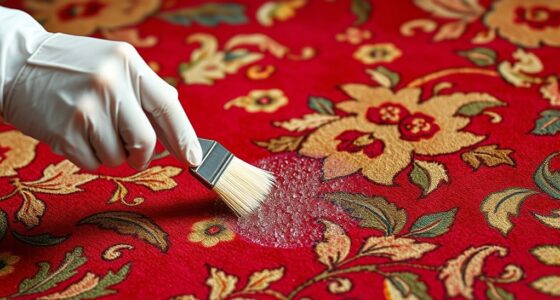Ozone treatment effectively eliminates stubborn odors by breaking down molecules through oxidation, making it a strong, chemical-free option. However, it poses health risks like respiratory irritation and skin contact if not used carefully. Environmental concerns include pollution and secondary pollutants. Proper precautions, such as ventilation and protective gear, are essential. To decide if ozone treatment suits your needs, it’s important to weigh its benefits against potential risks—you’ll find detailed insights if you explore further.
Key Takeaways
- Ozone treatment effectively neutralizes stubborn odors by oxidizing odor molecules into harmless substances like CO₂ and water.
- It works best in unoccupied spaces, especially for persistent odors from mold, smoke, or chemicals.
- Health risks include respiratory irritation, skin contact issues, and potential degradation of indoor materials if improperly used.
- Proper safety precautions, such as ventilation and protective gear, are essential to minimize health and environmental hazards.
- While offering thorough odor removal, ozone treatment may have higher costs and limited accessibility compared to traditional methods.
How Ozone Treatment Works to Eliminate Odors
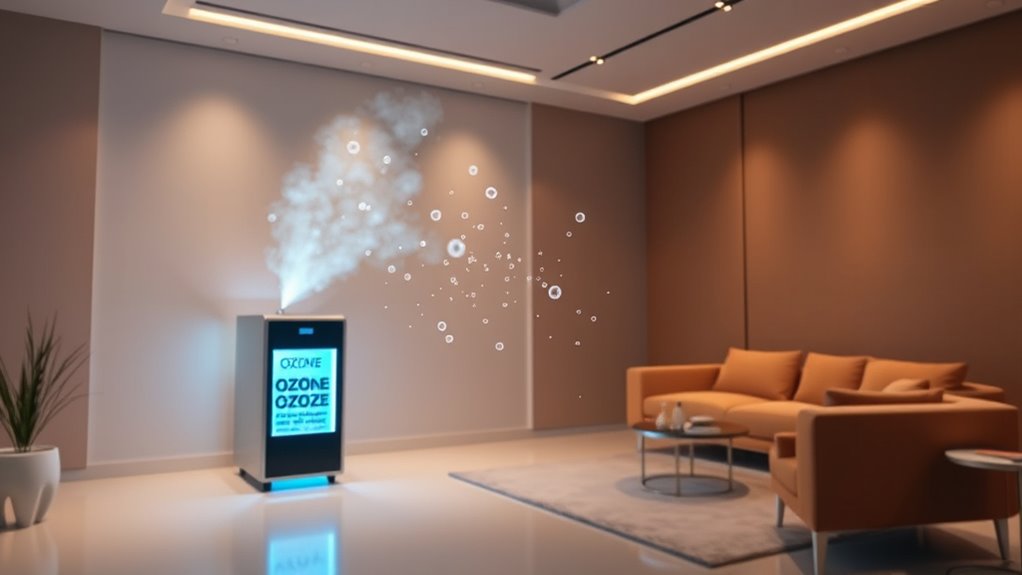
Ozone treatment works by generating ozone gas, a powerful oxidizer that reacts with odor-causing molecules in the air or on surfaces. Understanding ozone chemistry helps explain how this process eliminates odors. When ozone encounters odor molecules, it reacts with their chemical bonds, breaking them apart. This oxidation process neutralizes the molecules, transforming them into harmless substances like carbon dioxide and water. You’ll notice that ozone effectively targets a wide range of odors, from smoke to mold. Because of its reactive nature, ozone can reach into cracks and hidden areas, where traditional cleaning might miss odor sources. This chemical reaction is the core reason ozone treatment is so effective at removing stubborn odors and restoring fresh air in your space. Additionally, lifestyle factors such as proper ventilation and maintenance can enhance the effectiveness of ozone treatments. Incorporating ozone chemistry principles into treatment protocols can further optimize odor removal outcomes. Understanding the reactive nature of ozone can help users better appreciate its ability to neutralize even persistent odors effectively. Recognizing the importance of safety precautions ensures that ozone is used effectively and safely during treatments. Moreover, awareness of regulatory guidelines can help ensure ozone treatments are conducted responsibly and in compliance with safety standards.
Advantages of Using Ozone for Odor Removal
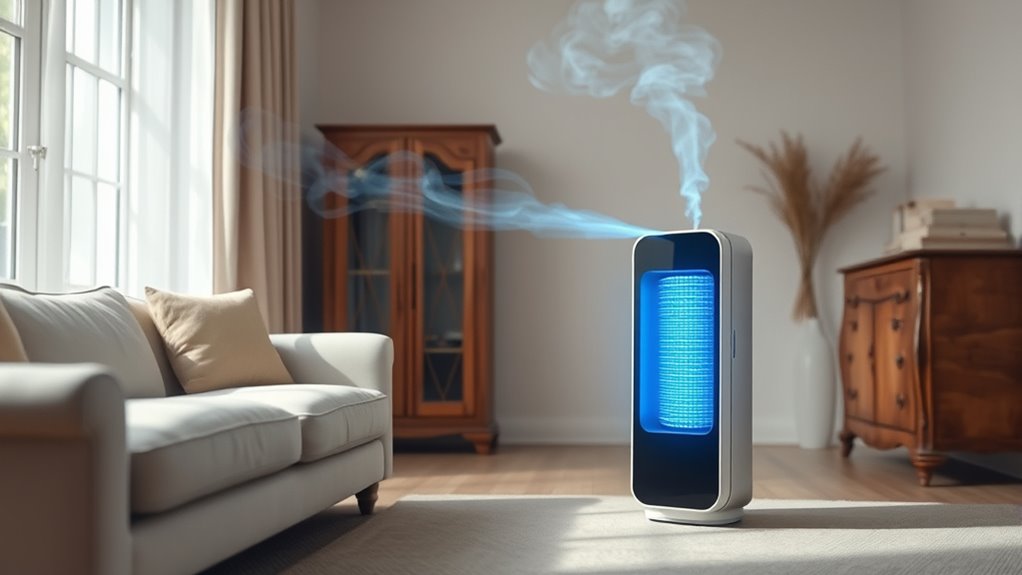
One of the key advantages of ozone treatment is its ability to quickly and effectively eliminate a wide variety of stubborn odors, from smoke and pet smells to mold and mildew. This process relies on chemical reactions, where ozone molecules react with odor-causing compounds, breaking them down at a molecular level. Unlike masking agents, ozone transforms odors into harmless substances, providing thorough air purification. It’s highly versatile, capable of treating large spaces and hard-to-reach areas, making it ideal for both residential and commercial settings. Additionally, ozone’s reactive nature allows it to neutralize a broad spectrum of odors simultaneously. As a result, you can enjoy fresher, cleaner air faster, with a process that’s both powerful and all-encompassing in removing persistent smells. For those interested in vehicle enhancements, Honda Tuning offers options to improve performance and handling, which can also contribute to a more comfortable and odor-free environment inside your vehicle. Moreover, understanding the chemical reactions involved can help users appreciate how ozone effectively breaks down complex odor molecules at the source. Furthermore, awareness of the risks and rewards of ozone treatment ensures safe and effective odor removal practices. Recognizing the importance of personal safety when using ozone is crucial to avoid potential health hazards during treatment.
Potential Health Risks Associated With Ozone Exposure

While ozone treatment is effective at removing odors, exposure to high concentrations of ozone can pose significant health risks. When ozone enters indoor air, it can irritate your respiratory system, causing coughing, chest discomfort, and shortness of breath. Prolonged exposure may worsen asthma symptoms and reduce lung function. Additionally, high ozone levels can cause skin irritation, leading to redness and itching upon contact. People with sensitive skin or respiratory conditions should be especially cautious. Ozone’s reactive nature means it can also degrade indoor materials, releasing secondary pollutants that might further irritate your skin and lungs. It is also important to consider indoor air quality when using ozone treatments to prevent unintended health issues. Using ozone responsibly involves understanding air purification methods and their effects on health. It’s essential to ensure proper ventilation and avoid exposure during ozone treatments to minimize these health risks. Proper ozone concentrations and adherence to safety guidelines are crucial for safe application. Understanding the principles of somatic therapy can also help in managing stress and health concerns related to environmental exposures. Additionally, regular monitoring of indoor pollutant levels can help prevent adverse health effects.
Environmental Impact of Ozone Generators
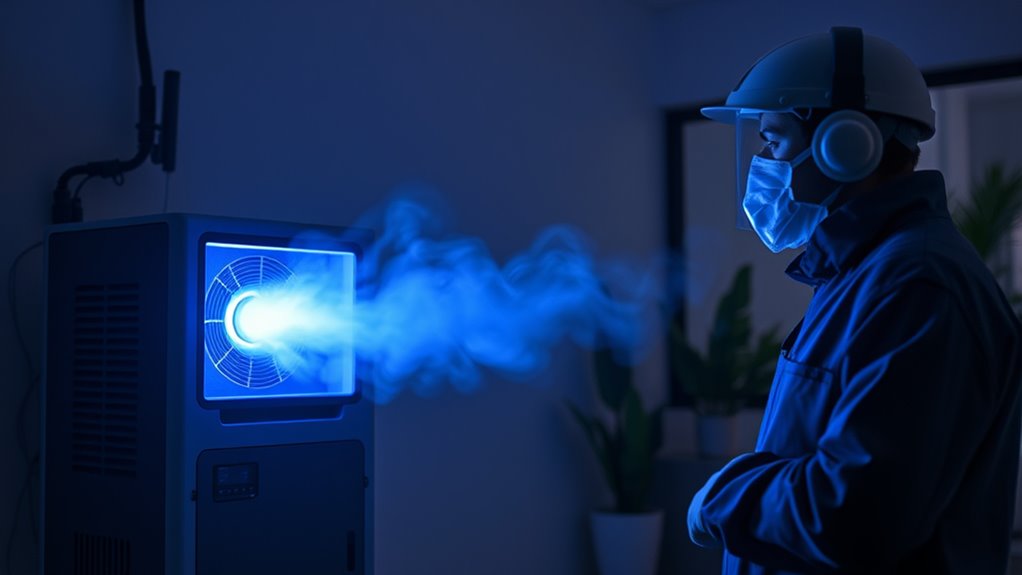
Have you ever considered how ozone generators impact the environment beyond their indoor use? While they effectively improve air quality indoors, their outdoor effects can be concerning. Ozone, a reactive molecule, can react with other chemicals, creating harmful byproducts that pollute the atmosphere. These chemical byproducts may contribute to smog formation and harm ecosystems. Additionally, ozone emissions can drift into surrounding areas, affecting wildlife and plant life. The environmental risks include:
- Degradation of air quality in outdoor environments
- Formation of secondary pollutants like particulate matter
- Contribution to smog and acid rain
- Impact on sensitive ecosystems and biodiversity
- The potential for ozone to react with other chemicals and produce harmful byproducts that exacerbate environmental pollution
Understanding these effects highlights that ozone generators, though useful indoors, can pose broader environmental challenges when their emissions are not properly managed.
Safety Precautions When Using Ozone Devices
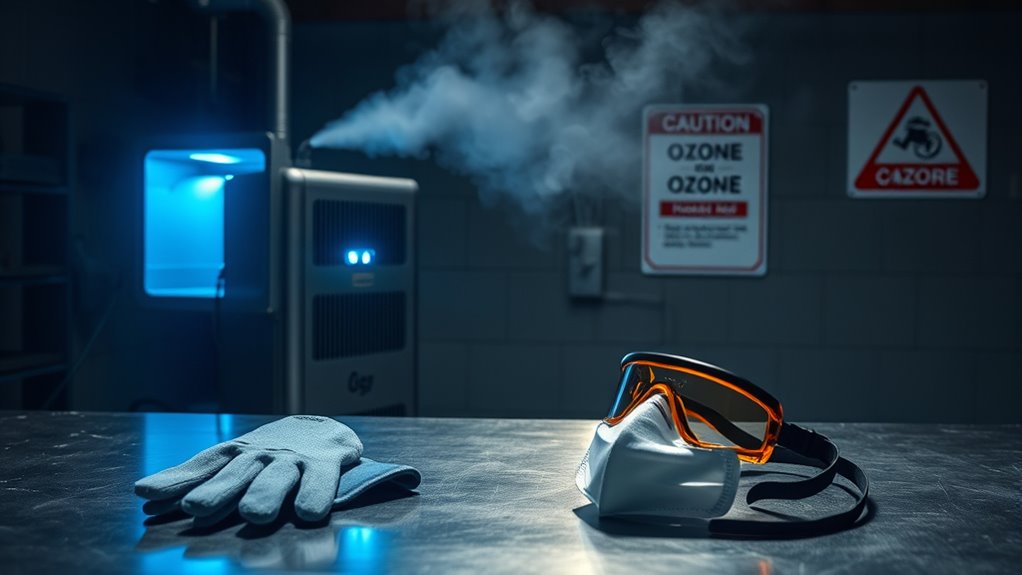
Using ozone generators safely is essential to prevent potential health risks and environmental issues. Always wear protective gear, such as gloves, goggles, and masks, to avoid inhaling ozone or coming into contact with its harmful effects. Before operating the device, ensure the area is clear of people and pets. Proper ventilation practices are vital; open windows and doors to allow fresh air to circulate during and after treatment. Turn off HVAC systems to prevent ozone from spreading unintentionally. Never use ozone generators in occupied spaces, and wait until the area is thoroughly ventilated before re-entering. Following these precautions helps minimize health hazards and guarantees effective, safe odor removal. Additionally, understanding raw food safety is important to prevent foodborne illnesses during treatment or cleaning procedures. Being aware of the effectiveness of security systems can also help protect your property while performing ozone treatments, especially if you have valuable equipment or supplies nearby. Proper ventilation techniques can significantly reduce ozone exposure risks and ensure the safety of everyone involved.
Situations Where Ozone Treatment Is Most Effective
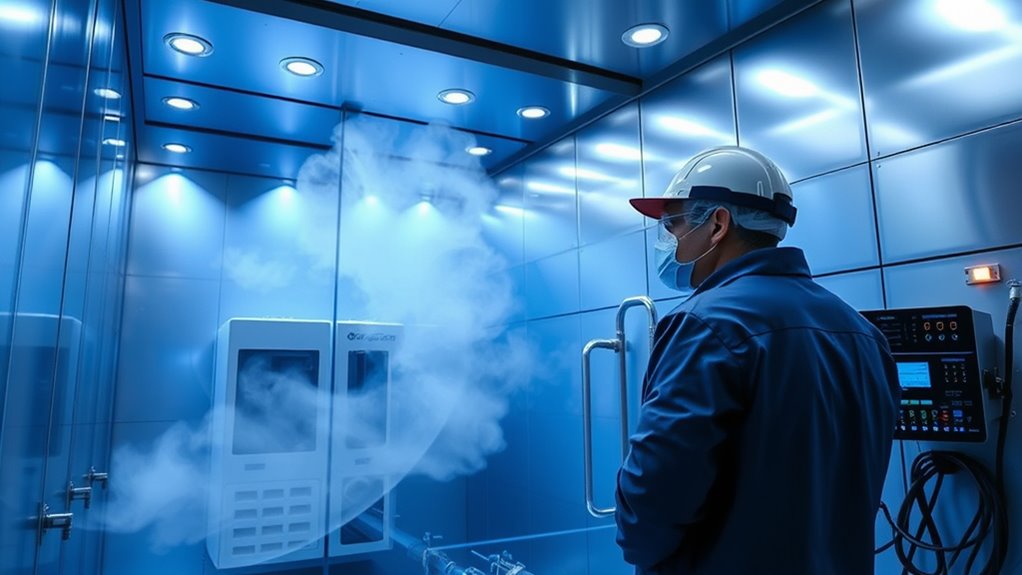
Ozone treatment is most effective in situations where odors are persistent, stubborn, or deeply embedded in surfaces. It’s especially useful in industrial applications, where strong smells from manufacturing or chemicals linger, and in artistic uses, such as restoring artwork or theater sets. You’ll see ideal results when odors have penetrated porous materials or complex environments. Consider these scenarios:
Ozone effectively eliminates stubborn odors in porous materials and complex environments.
- Removing smoke odors from commercial spaces
- Disinfecting and deodorizing industrial equipment
- Restoring artwork or set pieces with embedded scents
- Eliminating persistent pet or mold odors in large areas
In these cases, ozone’s strong oxidizing power can neutralize odors effectively. It’s a powerful tool for situations requiring deep, thorough odor removal where traditional methods fall short.
Limitations and When to Avoid Ozone Odor Removal

You should be cautious if anyone in your home is sensitive to ozone, as it can cause health issues. Ozone treatment also doesn’t work well on all types of odors, especially those embedded in porous materials. Knowing these limitations helps you decide when ozone might not be the right choice for odor removal.
Sensitive Individuals at Risk
Are there times when ozone treatment might pose risks to certain individuals? Yes, especially if you have skin sensitivity or respiratory health issues. People with asthma, chronic bronchitis, or other respiratory conditions may experience worsened symptoms from ozone exposure. Additionally, ozone can irritate the skin, eyes, and mucous membranes, posing risks for those with heightened skin sensitivity.
Consider avoiding ozone treatment if you or anyone in your household:
- Has pre-existing respiratory conditions
- Experiences skin allergies or sensitivities
- Is pregnant or elderly
- Has compromised immune health
In these cases, the potential health risks outweigh the benefits. Always consult a healthcare professional before opting for ozone odor removal, especially if you or your loved ones are vulnerable.
Ineffective for Certain Odors
While ozone treatments can be effective for many odors, they don’t work equally well for all types. Certain strong or stubborn smells, especially those originating from complex materials or deep within porous surfaces, often resist ozone’s chemical reactions. Industrial applications sometimes require alternative methods because ozone may not neutralize odors like pet urine, mold, or smoke residues effectively. In these cases, ozone’s limited ability to penetrate surfaces means it can’t fully break down the odor-causing compounds. Additionally, some odors result from chemical reactions that ozone simply cannot target or alter safely. When dealing with persistent or chemically resistant smells, relying solely on ozone may be ineffective. Knowing these limitations helps you decide when to seek other odor removal techniques for better results.
Comparing Ozone Treatment to Other Odor Elimination Methods

When comparing ozone treatment to other odor removal methods, you’ll want to contemplate how quickly and effectively each option works. Safety measures and precautions are also important, especially for methods that pose health risks. Additionally, examining costs and accessibility helps determine which solution fits your needs and budget best.
Effectiveness and Speed
Ozone treatment is known for its rapid and effective odor elimination compared to many traditional methods. It can neutralize stubborn smells swiftly, often within hours, unlike cleaning or chemical sprays that may only mask odors. Its strength lies in breaking down odor-causing molecules at a molecular level. When you choose ozone treatment, you benefit from:
- Quick turnaround times, reducing downtime
- Superior reduction of odor persistence
- Deep penetration into porous materials
- Minimal residue or chemical use
However, it’s essential to contemplate ozone safety and ensure proper application. While ozone is powerful against odors, improper use can be ineffective or risky. Its effectiveness depends on the odor’s source and severity, making it a compelling choice for fast, thorough odor removal.
Safety and Precautions
Ozone treatment’s rapid odor-neutralizing power comes with safety considerations that set it apart from traditional methods like chemical sprays or cleaning. Because ozone is a strong oxidizer, you need to wear protective gear, such as masks and gloves, to avoid inhalation or skin contact during treatment. Additionally, strict ventilation protocols are essential; you must ensure the area is well-ventilated before and after ozone use to prevent harmful residual ozone from lingering. Unlike chemical solutions, which often require no special precautions beyond basic cleaning, ozone carries risks if mishandled. Always follow manufacturer instructions and safety guidelines to protect yourself and others. Proper precautions make ozone treatment effective without compromising safety, unlike some other odor elimination methods.
Cost and Accessibility
Compared to traditional odor elimination methods like chemical sprays, air purifiers, or cleaning solutions, ozone treatment often involves higher upfront costs due to specialized equipment and professional installation. The cost comparison shows that ozone treatment can be more expensive initially, but it may offer longer-lasting results. However, accessibility challenges can limit its use, especially in smaller spaces or for DIY projects. You might encounter issues such as:
- Limited availability of professional services in rural areas
- Higher equipment costs for personal use
- Safety regulations restricting home-based ozone treatments
- Need for specialized knowledge to operate equipment safely
While ozone treatment is effective for persistent odors, these factors can make it less accessible and more costly compared to more straightforward options.
Regulatory Guidelines and Industry Standards for Ozone Use

Regulatory guidelines and industry standards play a crucial role in ensuring the safe and effective use of ozone treatments. These regulations help you maintain legal compliance, protecting both your health and your property. Industry standards set clear protocols for ozone generator operation, exposure limits, and safety measures, ensuring consistent practices across the industry. By following these guidelines, you minimize risks such as overexposure or incomplete odor removal. Many regions impose strict limits on ozone levels during and after treatment, emphasizing the importance of understanding local regulations. Adhering to industry standards not only safeguards your well-being but also ensures your treatment methods meet professional and legal requirements. Staying informed on these standards helps you use ozone treatments responsibly and effectively.
Making an Informed Decision: Is Ozone Treatment Right for You?
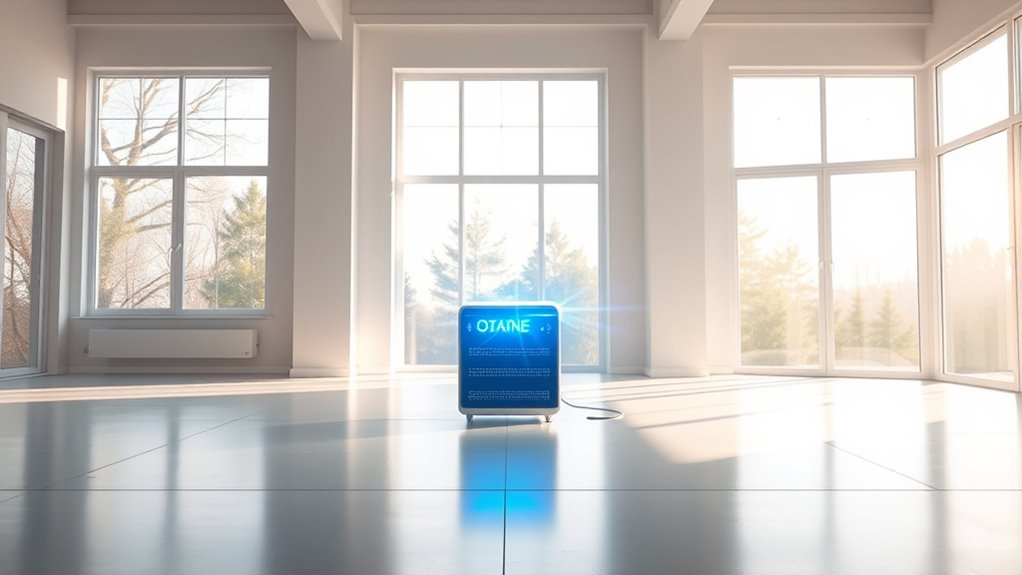
Before deciding whether ozone treatment is right for your needs, it’s important to evaluate your specific situation and goals. Consider the historical uses of ozone, which include sterilization and air purification, and how cultural perceptions influence its acceptance. Ozone’s reputation varies widely; some see it as a powerful disinfectant, while others associate it with health risks. To make an informed choice, reflect on:
- The severity of the odor problem
- Your sensitivity to ozone exposure
- Local regulations and safety guidelines
- Alternatives like traditional cleaning methods
Understanding these factors helps you weigh the potential benefits against risks. Recognize that cultural perceptions and past uses shape opinions, but always prioritize safety and effectiveness when deciding if ozone treatment aligns with your needs.
Frequently Asked Questions
Can Ozone Treatment Eliminate All Types of Odors Effectively?
You might wonder if ozone treatment can eliminate all odors effectively. While it excels at odor neutralization and scent eradication, it doesn’t work equally well on every odor source, especially deep-seated or porous material odors. For the best results, consider the type of odor and its cause. Ozone treatment is a powerful tool, but it’s not a universal solution, so understanding its limits helps you decide if it’s right for your situation.
How Long Does an Ozone Treatment Typically Take?
Imagine a miracle that can erase odors overnight—well, ozone treatment gets close! Typically, the treatment duration depends on the ozone concentration used; higher levels might take just a few hours, while lower levels can stretch to 24 hours or more. You’ll need to evaluate room size and odor severity, but generally, plan for several hours to ensure the ozone concentration effectively neutralizes stubborn smells.
Are There Any Long-Term Health Effects From Repeated Ozone Exposure?
You might wonder if repeated ozone exposure causes long-term health effects. While occasional use is generally safe, repeated exposure can irritate your lungs, worsen asthma, or cause other respiratory issues over time. It’s important to limit exposure, especially if you have pre-existing conditions. Always follow safety guidelines and guarantee proper ventilation during ozone treatments to reduce potential risks and protect your long-term health.
What Are the Signs of Improper Ozone Generator Use?
You might think ozone generators are foolproof, but improper use can pose safety hazards. Watch for signs like lingering ozone smells, unexplained respiratory irritation, or headaches, which indicate the device isn’t functioning correctly. Device malfunction can also cause uneven ozone distribution, risking your health. Always follow manufacturer instructions carefully, ventilate the area after use, and avoid direct breathing during operation to stay safe and prevent hazards.
How Does Ozone Treatment Compare in Cost to Alternative Methods?
When comparing ozone treatment costs to alternatives, you’ll find it’s often more affordable initially, thanks to quick setup and lower material expenses. An affordability analysis shows that ozone can save you money over time, especially for large or persistent odors. However, consider ongoing safety measures and potential re-treatments. Overall, ozone treatment offers a competitive cost comparison, making it a viable option if you balance upfront costs with long-term effectiveness.
Conclusion
Deciding whether ozone treatment is right for you isn’t straightforward. While it can effectively eliminate stubborn odors, the potential health and environmental risks mean you should weigh your options carefully. Are you willing to accept the safety precautions and limitations? Or could other methods serve your needs better? The choice is yours, but one thing’s certain—understanding the risks and rewards will help you make the most informed decision. Will ozone be your solution or your cautionary tale?



